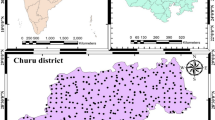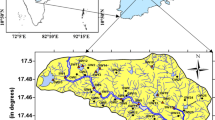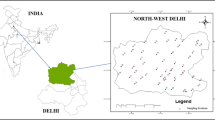Abstract
Groundwater contamination is a major concern in front of the scientific community because it is directly related to human health, especially in arid and semi-arid regions. Therefore, a comprehensive study was engaged to evaluate the water quality, potability, and human health risk assessment due to the consumption of fluoride- and nitrate-contaminated water in Jhunjhunu district of Rajasthan. In order to assess the water quality, samples were collected from 87 locations in the study region, and a total of 16 parameters were analyzed as per the standard methods. The results showed that the value of the number of quality parameters consisting of pH, EC, TDS, fluoride, chloride, nitrate, sulfate, total hardness, calcium, magnesium, and total alkalinity was higher than the recommended limit of BIS and WHO. The fluoride in 11% and nitrate in 6% of samples were observed to exceed the permissible limit of WHO. The results of risk assessment due to fluoride and nitrate revealed that hazard index values of 71% of groundwater samples for males, 78% of groundwater samples for females, and 75% of groundwater samples for children were greater than 1, indicating the significant health hazard due to consumption of groundwater. The water quality index (WQI) found that 39% of groundwater samples belong to categories that cannot be used for drinking purposes. Principal component analysis (PCA) reduced the large number of variables affecting the overall quality and chemistry of groundwater and determined four major components which account for 69.50% variance in the data. PCA concluded that both geogenic and anthropogenic sources of contamination influenced the groundwater of the study area.








Similar content being viewed by others
Data availability
All data generated or analyzed during this study are included in this manuscript and supplementary file.
References
Adimalla, N. (2019). Human and ecological risk assessment : An international spatial distribution, exposure, and potential health risk assessment from nitrate in drinking water from semi-arid region of South India assessment from nitrate in drinking water from semi-arid. Human and Ecological Risk Assessment 1–25. https://doi.org/10.1080/10807039.2018.1508329
Adimalla, N., Marsetty, S. K., & Xu, P. (2020). Assessing groundwater quality and health risks of fluoride pollution in the Shasler Vagu (SV) watershed of Nalgonda. India. Human and Ecological Risk Assessment, 26(6), 1569–1588. https://doi.org/10.1080/10807039.2019.1594154
Ahada, C. P., & Suthar, S. (2017). Hydrochemistry of groundwater in North Rajasthan, India: Chemical and multivariate analysis. Environmental Earth Sciences, 76(5), 1–16.
Ali, S., Fakhri, Y., Golbini, M., Thakur, S. K., Alinejad, A., Parseh, I., Shekhar, S., & Bhattacharya, P. (2019). Concentration of fluoride in groundwater of India: A systematic review, meta- analysis and risk assessment. Groundwater for Sustainable Development. https://doi.org/10.1016/j.gsd.2019.100224
APHA. (2017). Standard methods for the examination of water and wastewater (23rd ed.). American Public Health Association/American Water Works Association/ Water Environment Federation.
Bhardwaj, S., Shukla, D. P., & Halder, A. (2020). Spatial distribution of uranium and chemo-radiological assessment in Hamirpur district, Himachal Pradesh, India. Journal of Radioanalytical and Nuclear Chemistry, 324(2), 467–480.
BIS. (2012). Bureau of Indian standards specification for drinking water IS: 10500: 91. Bureau of Indian standards.
Brown R. M., McClellan N. I., Deininger R. A, and Tozer R. G. (1970). A waterquality index—do we dare? Water Sew Works, 117, 339–343.
Chaudhary, V., & Satheeshkumar, S. (2018). Assessment of groundwater quality for drinking and irrigation purposes in arid areas of Rajasthan. India. Applied Water Science, 8(8), 1–17.
CGWB. (2008). Groundwater brochure, Jhunjhunu district, Western region Jaipur, Central Ground Water Board, Ministry of Water Resources, Government of India.
CGWB. (2018). Groundwater quality in shallow aquifers in India. Central Ground Water Board, Ministry of Water Resources RD and GR, Government of India
CGWB. (2021). Central Ground Water Board, Department of Water Resources, River Development & Ganga Rejuvenation, Ministry of Jal Shakti, Western Region, Jaipur, Government of India. November 2021, Ground Water Year Book 2020 – 2021. Retrieved October 28, 2022, from http://cgwb.gov.in/Regions/WR/Reports/GW%20Year%20Book%202020-21-Rajasthan.pdf
CWC. (2019). Water and related statistics. Central Water Commission, Department of Water Resources, RD and GR, Ministry of Jal Shakti, Government of India, New Delhi, India.
Duvva, L. K., Panga, K. K., Dhakate, R., & Himabindu, V. (2022). Health risk assessment of nitrate and fluoride toxicity in groundwater contamination in the semi-arid area of Medchal. South India. Applied Water Science, 12(1), 1–21. https://doi.org/10.1007/s13201-021-01557-4
Eggers, M. J., Doyle, J. T., Lefthand, M. J., Young, S. L., Moore-Nall, A. L., Kindness, L., et al. (2018). Community engaged cumulative risk assessment of exposure to inorganic well water contaminants, crow reservation, Montana. International Journal of Environmental Research and Public Health, 15(1). https://doi.org/10.3390/ijerph15010076
Freeze, R. A, & Cherry, J. A. (1979). Groundwater. Prentice- Hall.
Gugulothu, S., Subba Rao, N., Das, R., Duvva, L. K., & Dhakate, R. (2022). Judging the sources of inferior groundwater quality and health risk problems through intake of groundwater nitrate and fluoride from a rural part of Telangana. India. Environmental Science and Pollution Research, 29(32), 49070–49091. https://doi.org/10.1007/s11356-022-18967-9
Hem, J. D. (1991). Study and interpretation of the chemical characteristics of natural water: USGS professional paper book 2254. Scientific Publishers.
Iqbal, J., Su, C., Rashid, A., Yang, N., Baloch, M. Y. J., Talpur, S. A., et al. (2021). Hydrogeochemical assessment of groundwater and suitability analysis for domestic and agricultural utility in southern Punjab. Pakistan. Water (switzerland), 13(24), 2–3. https://doi.org/10.3390/w13243589
Jandu, A., Malik, A., & Dhull, S. B. (2021). Fluoride and nitrate in groundwater of rural habitations of semiarid region of northern Rajasthan, India: A hydrogeochemical, multivariate statistical, and human health risk assessment perspective. Environmental Geochemistry and Health, 43(10), 3997–4026. https://doi.org/10.1007/s10653-021-00882-6
Joshi, A., & Seth, G. (2011). Hydrochemical profile for assessing the groundwater quality of Sambhar lake city and its adjoining area. Environmental Monitoring and Assessment, 174(1), 547–554.
Kashyap, C. A., Ghosh, A., Singh, S., Ali, S., Singh, H. K., Chandrasekhar, T., & Chandrasekharam, D. (2020). Distribution, genesis and geochemical modeling of fluoride in the water of tribal area of Bijapur district, Chhattisgarh, central India. Groundwater for Sustainable Development, 11(April), 100403. https://doi.org/10.1016/j.gsd.2020.100403
Kaur, L., Rishi, M. S., Sharma, S., Sharma, B., Lata, R., & Singh, G. (2019). Hydrogeochemical characterization of groundwater in alluvial plains of river Yamuna in northern India: An insight of controlling processes. Journal of King Saud University - Science, 31(4), 1245–1253. https://doi.org/10.1016/j.jksus.2019.01.005
Kimambo, V., Bhattacharya, P., Mtalo, F., Mtamba, J., & Ahmad, A. (2019). Fluoride occurrence in groundwater systems at global scale and status of defluoridation – State of the art. Groundwater for Sustainable Development, 9, 100223. https://doi.org/10.1016/j.gsd.2019.100223
Kothari, V., Vij, S., Sharma, S. K., & Gupta, N. (2021). Correlation of various water quality parameters and water quality index of districts of Uttarakhand. Environmental and Sustainability Indicators, 9(December 2020), 100093. https://doi.org/10.1016/j.indic.2020.100093
Krishan, G., Bhagwat, A., Sejwal, P., Yadav, B. K., Kansal, M. L., Bradley, A., et al. (2022). Assessment of groundwater salinity using principal component analysis ( PCA ): A case study from Mewat ( Nuh ), Haryana. India. Environmental Monitoring and Assessment. https://doi.org/10.1007/s10661-022-10555-1
Li, P., & Qian, H. (2018). Water resources research to support a sustainable China. International Journal of Water Resources Development, 34(3), 327–336. https://doi.org/10.1080/07900627.2018.1452723
Nair P. K. M., & Augustine, L. F. (2018). Country-specific nutrient requirements & recommended dietary allowances for Indian: Current status & future directions, (November), 522–530. https://doi.org/10.4103/ijmr.IJMR
NITI Aayog. (2020). Government of India. Retrieved October 13, 2022, from https://niti.gov.in/content/life-expectancy
NIN-ICMR. (2011). Dietary guidelines for Indians -A manual. National Institute of Nutrition - Indian Council of Medical Research.
Panghal, V., Singh, A., Kumar, R., Kumari, G., Kumar, P., & Kumar, S. (2021). Soil heavy metals contamination and ecological risk assessment in Rohtak urban area, Haryana (India). Environmental Earth Sciences, 80(21), 1–20. https://doi.org/10.1007/s12665-021-10028-7
Rahman, A., Mondal, N. C., & Tiwari, K. K. (2021). Anthropogenic nitrate in groundwater and its health risks in the view of background concentration in a semi arid area of Rajasthan, India. Scientific Reports, 11(1), 1–13. https://doi.org/10.1038/s41598-021-88600-1
Rao, N. S., Dinakar, A., & Kumari, B. K. (2021a). Appraisal of vulnerable zones of non-cancer-causing health risks associated with exposure of nitrate and fluoride in groundwater from a rural part of India. Environmental Research, 202(June), 111674. https://doi.org/10.1016/j.envres.2021.111674
Rao, N. S., Dinakar, A., Sravanthi, M., & Kumari, B. K. (2021b). Geochemical characteristics and quality of groundwater evaluation for drinking, irrigation, and industrial purposes from a part of hard rock aquifer of South India. Environmental Science and Pollution Research, 28(24), 31941–31961. https://doi.org/10.1007/s11356-021-12404-z
Rao, N. S., Das, R., & Gugulothu, S. (2022a). Understanding the factors contributing to groundwater salinity in the coastal region of Andhra Pradesh. India. Journal of Contaminant Hydrology, 250, 104053. https://doi.org/10.1016/j.jconhyd.2022.104053
Rao, N. S., Dinakar, A., & Sun, L. (2022b). Estimation of groundwater pollution levels and specific ionic sources in the groundwater, using a comprehensive approach of geochemical ratios, pollution index of groundwater, unmix model and land use/land cover–A case study. Journal of Contaminant Hydrology, 248, 103990. https://doi.org/10.1016/j.jconhyd.2022.103990
Rao, N. S., Ravindra, B., & Wu, J. (2020). Human and ecological risk assessment : An international geochemical and health risk evaluation of fluoride rich groundwater in Sattenapalle Region, Guntur district, Andhra Pradesh, India. Human and Ecological Risk Assessment: An International Journal, 1–33.https://doi.org/10.1080/10807039.2020.1741338
Rashid, A., Ayub, M., Khan, S., Ullah, Z., Ali, L., Gao, X., et al. (2022). Hydrogeochemical assessment of carcinogenic and non-carcinogenic health risks of potentially toxic elements in aquifers of the Hindukush ranges, Pakistan: Insights from groundwater pollution indexing, GIS-based, and multivariate statistical approaches. Environmental Science and Pollution Research, (0123456789). https://doi.org/10.1007/s11356-022-21172-3
Satyanarayana, E., Dhakate, R., Kumar, D. L., Ravindara, P., & Muralidhara, M. (2017). Hydrochemical characteristics of groundwater quality with special reference to fluoride concentration in parts of Mulugu-Venkatapur Mandals, Warangal district, Telangana. Journal of Geological Society of India, 89, 247–258. https://doi.org/10.1007/s12594-017-0597-8
Shirke, K. D., Kadam, A., & Pawar, N. J. (2020). Human and ecological risk assessment : An international health risk assessment and prevalence of fluoride in groundwater around the geological diversity of Ambadongar South Gujarat, India. Human and Ecological Risk Assessment: An International Journal, 1–20.https://doi.org/10.1080/10807039.2020.1858270
Singh, C. K., & Mukherjee, S. (2014). Aqueous geochemistry of fluoride enriched groundwater in arid part of Western India. Environmental Science and Pollution Research, 22(4), 2668–2678.
Sohrabi, N., Kalantari, N., Amiri, V., Saha, N., Berndtsson, R., Bhattacharya, P., & Ahmad, A. (2021). A probabilistic-deterministic analysis of human health risk related to the exposure to potentially toxic elements in groundwater of Urmia coastal aquifer (NW of Iran) with a special focus on arsenic speciation and temporal variation. Stochastic Environmental Research and Risk Assessment, 35(7), 1509–1528. https://doi.org/10.1007/s00477-020-01934-6
Stumm, W., & Morgan, J. J. (1981). Aquatic chemistry: Aquatic Chemistry: An Introduction Emphasizing Chemical Equilibria in Natural Waters. A Wiley-Interscience-Publication.
Subba Rao, N. (2011). High-fluoride groundwater. Environmental Monitoring and Assessment, 176(1–4), 637–645. https://doi.org/10.1007/s10661-010-1609-y
Subba Rao, N. (2018). Groundwater quality from a part of Prakasam District, Andhra Pradesh. India. Applied Water Science, 8(1), 1–18. https://doi.org/10.1007/s13201-018-0665-2
Subba Rao, N., Dinakar, A., Surya Rao, P., Rao, P. N., Madhnure, P., Prasad, K. M., & Sudarshan, G. (2016). Geochemical processes controlling fluoride-bearing groundwater in the granitic aquifer of a semi-arid region. Journal of the Geological Society of India, 88(3), 350–356. https://doi.org/10.1007/s12594-016-0497-3
Subba Rao, N., Srihari, C., Deepthi Spandana, B., Sravanthi, M., Kamalesh, T., & Abraham Jayadeep, V. (2019). Comprehensive understanding of groundwater quality and hydrogeochemistry for the sustainable development of suburban area of Visakhapatnam, Andhra Pradesh. India. Human and Ecological Risk Assessment, 25(1–2), 52–80. https://doi.org/10.1080/10807039.2019.1571403
Subba Rao, N., Subrahmanyam, A., & Babu Rao, G. (2013). Fluoride-bearing groundwater in Gummanampadu sub-basin, Guntur district, Andhra Pradesh. India. Environmental Earth Sciences, 70(2), 575–586.
Subba Rao, N., Surya Rao, P., Venktram Reddy, G., Nagamani, M., Vidyasagar, G., & Satyanarayana, N. L. V. V. (2012). Chemical characteristics of groundwater and assessment of groundwater quality in Varaha River Basin, Visakhapatnam District, Andhra Pradesh. India. Environmental Monitoring and Assessment, 184(8), 5189–5214. https://doi.org/10.1007/s10661-011-2333-y
Suthar, S., Bishnoi, P., Singh, S., Mutiyar, P. K., Nema, A. K., & Patil, N. S. (2009). Nitrate contamination in groundwater of some rural areas of Rajasthan. India. Journal of Hazardous Materials, 171(1–3), 189–199.
Suthar, S., Garg, V. K., Jangir, S., Kaur, S., Goswami, N., & Singh, S. (2008). Fluoride contamination in drinking water in rural habitations of Northern Rajasthan. India. Environmental Monitoring and Assessment, 145(1), 1–6.
Tanwer, N., Khayalia, P., Deswal, M., Laura, J. S., & Khosla, B. (2022) Spatial distribution of uranium in groundwater and its health risk assessment in Haryana, India. Rasayan Journal of Chemistry, 15, 343–349. https://doi.org/10.31788/RJC.2022.1516608
Taylor, R. (1990). Interpretation of the correlation coefficient: A basic review. Journal of Diagnostic Medical Sonography, 6(1), 35–39.
Ullah, Z., Talib, M. A., Rashid, A., Ghani, J., Shahab, A., Irfan, M., et al. (2021b). Hydrogeochemical investigation of elevated arsenic based on entropy modeling, in the aquifers of district sanghar, sindh, Pakistan. Water (Switzerland), 13(23). https://doi.org/10.3390/w13233477
Ullah, Z., Xu, Y., Zeng, X. C., Rashid, A., Ali, A., Iqbal, J., et al. (2022a). Non-carcinogenic health risk evaluation of elevated fluoride in groundwater and its suitability assessment for drinking purposes based on water quality index. International Journal of Environmental Research and Public Health, 19(15). https://doi.org/10.3390/ijerph19159071
USEPA. (2006). USEPA region III Risk-based concentration table: Technical background information. United States Environmental protection Agency.
USEPA. (2014). Human health evaluation manual, supplemental guidance: Update of standard default exposure factors-OSWER Directive 9200.1–120, p. 6. United States Environmental Protection Agency, Washington, DC, USA.
USEPA. (2017). Regional screening levels (RSLs)–G eneric tables; Retrieved May 10, 2022, from https://www.epa.gov/risk/regional-screening-levels-rsls-generictables
USEPA. (2020). Regional screening levels (RSLs)–Generic tables; Retrieved May 10, 2022, from, https://www.epa.gov/risk/regional-screening-levels-rsls-generic-tables
Wagh, V. M., Panaskar, D. B., Mukate, S. V., & Nashik, R. B. (2019). Human and ecological risk assessment : An international nitrate associated health risks from groundwater of Kadava River Basin Nashik, Maharashtra, India. Human and Ecological Risk Assessment: An International Journal, 1–19. https://doi.org/10.1080/10807039.2018.1528861
Whitford, G. M., Pashley, D. H., & Stringer, G. I. (1976). Fluoride renal clearance: A pH-dependent event. American Journal of Physiology-Legacy Content, 230(2), 527–532.
WHO. (2017). Guidelines for drinking water quality: Fourth edition incorporating the first addendum. World Health Organization.
Wu, J., & Sun, Z. (2016). Evaluation of shallow groundwater contamination and associated human health risk in an alluvial plain impacted by agricultural and industrial activities, mid-west China. Exposure and Health, 8(3), 311–329.
Wu, J., Yin, Y., & Wang, J. (2018). Hydrogen-based membrane biofilm reactors for nitrate removal from water and wastewater. International Journal of Hydrogen Energy, 43(1), 1–15. https://doi.org/10.1016/j.ijhydene.2017.10.178
Acknowledgements
The authors would like to acknowledge members of TSC-4, NRFCC, BRNS; HPD, HS&E Group, BARC, and NUP, for their continuous support in the execution of the project. The authors are also thankful to Maharshi Dayanand University, Rohtak, for providing all the facilities required to carry out this project. Authors acknowledge the technical help for ArcGIS by Abhishek Kumar and Pankaj Yadav, Research Scholars, Department of Geography, Maharshi Dayanand University, Rohtak, Haryana.
Funding
This study was funded by Board Research in Nuclear Sciences, Department of Atomic Energy under National Uranium Project with sanction no. 36(4)/14/18/2017-BRNS dated 04–12-2017.
Author information
Authors and Affiliations
Contributions
Naresh Tanwer has done experimental, analyzed data, and wrote initially draft of manuscript. Meena Deswal helped in experimental and analysis of data. Pradeep Khyalia helped in experimental and analysis of data. Jitender Singh Laura conceptualized the work and critical reviewing of manuscript. Babita Khosla conceptualized the work, drafting, and critical reviewing of manuscript. All authors have read, understood, and have complied the work done in the paper.
Corresponding author
Ethics declarations
Conflict of interest
The authors declare no competing interests.
Additional information
Publisher's Note
Springer Nature remains neutral with regard to jurisdictional claims in published maps and institutional affiliations.
Supplementary Information
Below is the link to the electronic supplementary material.
Rights and permissions
Springer Nature or its licensor (e.g. a society or other partner) holds exclusive rights to this article under a publishing agreement with the author(s) or other rightsholder(s); author self-archiving of the accepted manuscript version of this article is solely governed by the terms of such publishing agreement and applicable law.
About this article
Cite this article
Tanwer, N., Deswal, M., Khyalia, P. et al. Fluoride and nitrate in groundwater: a comprehensive analysis of health risk and potability of groundwater of Jhunjhunu district of Rajasthan, India. Environ Monit Assess 195, 267 (2023). https://doi.org/10.1007/s10661-022-10886-z
Received:
Accepted:
Published:
DOI: https://doi.org/10.1007/s10661-022-10886-z




